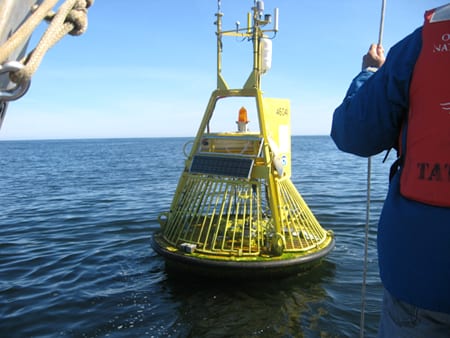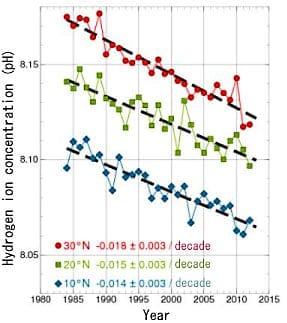By Daniel de la Calle
We cannot let the month end and watch the season slowly fade out without a postful of links, videos, news and photos on Ocean Acidification:
»The Oceanography Laboratory at Villefranche-sur-Mer (France) is deploying nine “mesocosms” (52 m3) over a 30 days period in order to cover the range of pCO2 anticipated for the end of the present century. These “mesocosms” are 15 meter deep plastic tubes closed at the bottom to collect organic matter and open at the top to remain in contact with the atmosphere. 25 researchers from six European countries are taking part in the tests, the second of their kind in the Mediterranean. While the first experiment, conducted in June/July 2012 in Corsica, was dedicated to the assessment of ocean acidification effects during the summer oligotrophic period, this second one will take place during the winter-spring phytoplanktonic bloom. Here is a “France 3” news piece on the story:
Une expérience de grande ampleur à Villefranche… por France3Nice
SOURCE
»“Taking Action against Ocean Acidification – A review of management and policy options”. An interview with lecturer Ryan Kelly (Center for Ocean Solutions), Jean-Pierre Gattuso (Laboratoire d’océanographie de Villefranche) and Raphaël Billé (IDDRI) in the monthly seminar “Séminaire du développement durable et économie de l’environnement” organized jointly by IDDRI, the Sustainable Development Center EDF at the Ecole Polytechnique, and the Columbia Global Centers Europe at Reid Hall. Held in Paris in December 2012.
»Plymouth Marine Laboratory (UK) will host the 3rd Annual Sea Surface Ocean Acidification Meeting on April 11th, 2013.
MORE INFO
»Dr. Ken Caldeira, from the Carnegie Institution for Science’s Department of Global Ecology speaking at Stanford University. He discusses long-term perspectives and near-term actions relating to ocean acidification.
»Ocean Acidification may affect the Great Lakes in the same was it is altering the oceans, according to modeling the study of carbon cycles by Galen McKinley, Professor of Atmospheric and Oceanic Sciences at the University of Wisconsin. It is clear this is a more complex environment, already severely affected by runoff from cities and agriculture and infested with invasive zebra and quagga mussels that absorb large amounts of calcium carbonate to build their shells.
“One potential area where we might get helped out with is impacts to quagga and zebra mussels,” says McKinley. “Evidence shows they do not like the lower pH.”
But nobody can guess the outcome of this mix of pollution, Acidification and invasive species until some research is done. “Right now we don’t have enough consistent and detailed measurements to accurately capture what the pH level even is and if it is permanently changing,” says McKinley.
NOAA has proposed to implement the network of preexisting mooring stations in the open waters of each Great Lake with carbon sensors and to study how local organisms respond to greater acidity to be able to model potential impacts to the food web. Photo: NOAA
Photo: NOAA
SOURCE
»“The Japan Meteorological Agency (JMA) announced last November that it would start releasing periodical monitoring information on ocean acidification, the first of its kind in Japan, along with global warming information using the long-term observational data gathered by its research vessels. The monitoring information will be available in a column of the “Oceanic Carbon Cycle” on JMA’s website.”
Photo: Japan Meteorological Agency
SOURCE
»On THIS link you will find a presentation on “Ocean Acidification / N2O” by Mr. Sakae Toyoda, from Tokyo Institute of Technology at Kavli Frontiers of Science symposium series of the National Academy of Sciences.
»“Ocean acidification and nitrous oxide”
By Michael Beman, University of California, Merced
“Human activities have fundamentally altered the chemistry of the atmosphere and ocean, ultimately pushing our planet into a new geological period known as the ‘Anthropocene.’ While human-driven increases in atmospheric carbon dioxide (CO2) concentrations—and their strong connection with climate change—are well-known, atmospheric nitrous oxide (N2O) concentrations have increased in parallel with CO2. N2O is both a strong greenhouse gas and the dominant destroyer of stratospheric ozone; the steady increase in N2O concentrations is driven primarily by agricultural fertilization, yet N2O is produced by multiple microbial groups that interact in complicated ways, and that may respond to other forms of environmental change. At the same time, climate change is not the only effect of elevated CO2: 25-33% of human-generated CO2 dissolves in the ocean, where it forms a weak acid and reduces ocean pH—a process known as ‘ocean acidification.’ pH is fundamental for ocean chemistry and ocean organisms, and changes in dissolved nutrients, metals, and forms of inorganic carbon are an expected consequence of future ocean acidification. Ocean pH is projected to decline by 0.3-0.4 units by the end of the century, producing wide-ranging effects that include reduced calcification in corals, shellfish, and phytoplankton; altered physiology in fish and other animals; and changes in ocean biogeochemical cycles. In this overview talk, I will present the drivers behind ocean acidification and increased N2O, the underlying dynamics of these changes, their projected effects, and their ultimate interactions.“


